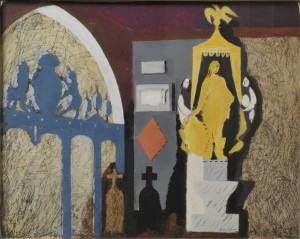In the early 17th century, Sir John St.John undertook far-reaching work to remodel the church, constructing a family chapel and a series of monuments to display his family pedigree and prestige. Admired by generations of antiquarians, these monuments have contributed to St. Mary's reputation as one of the most important small parish churches in England.
Sir John employed leading artists of the day, such as the master glass painter Abraham Van Linge, who created the east window which traces the descent of the manor of Lydiard Tregoze to the St.John family. The splendid polyptych, attributed to William Larkin, follows a similar theme. Its great doors are covered in heraldic and genealogical panels that open to reveal a life-size painting of Sir John and nine members of his immediate family.
Sir John's own extravagant memorial barely fits within the south chapel, in contrast to the quaint modesty of an earlier Elizabethan monument to his grandparents, Nicholas St.John and Elizabeth (Blount).
Sir John's last commission, The Golden Cavalier, shows his beloved son, Captain Edward St.John, who died from wounds he received fighting for King Charles II at the 2nd Battle of Newbury. For followers of that period in English history, a fine monument showing the kneeling figures of his uncle, Sir Giles Mompesson, and his aunt, Katherine St.John, will be of particular interest. A very different character to Sir John, Sir Giles was widely regarded as a notorious criminal, epitomising the corruption of the early Stuart regime.
Browse the collection for historic and contemporary photographs of all the monuments and in-depth research on their provenance and artistry. Please also see Heraldry and Genealogy sections of this website.





